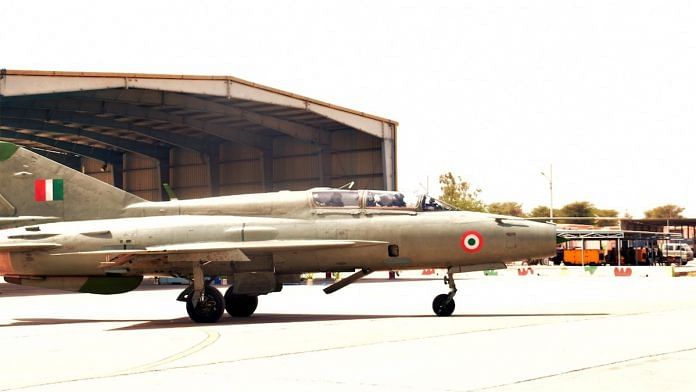The Indian Air Force recently lost a young warrior in a MiG-21 Bison accident on 21 May. On 27 May, No 23 Squadron—‘Panthers’ as they call themselves—flew a ‘Missing Man’ formation over the base led by the Commanding Officer. There were two reasons for this: One, to honour the departed warrior, and two, to honour a tradition.
The tradition is that after a fatal accident the first sortie in the Squadron is flown by the Commanding Officer (CO) himself – indicating that while the Squadron grieves for the departed comrade, life must go on and the Squadron must get back to its assigned task. This particular Panther mission had an additional significance. Flying in the formation was Air Chief Marshal RKS Bhadauria himself, who is also the senior-most Panther in service. Besides joining the CO and the Squadron personnel in the tribute, it also showed his faith in an aeroplane that has had a not-so-good reputation these past few years.
The CO, of course, was living up to the tradition that Commanding Officers lead from the front.
Also read: 11 down in 5 yrs, 3 in 2021, but many in IAF still swear by MiG-21s despite its ‘safety record’
Role of the commanding officer
The aviation horizon is widening and with advances in computing power, aerodynamics and engine technology, newer and fancier aeroplanes are appearing on the flight lines; notwithstanding the advances being made, certain traditions are unaffected and define military aviation. And, upholding these traditions is that one man at the apex of a flying unit, the Commanding Officer. ‘Old man’ to the rest of the clan that occupies the crew room, he (and very soon, a she) sits on a pedestal of his Unit’s history written in sweat and blood (literally) of officers and men who served earlier in that Unit. Accidents happen, as much as one would like to wish them away, and unfortunately some result in fatalities.
When a ‘fatal’ happens in a Unit, it is a loss that cannot be described in words. The guy with whom you had a drink the previous night in the bar, or who was perhaps sitting next to you in the formation briefing that was done before the sortie, or your buddy with whom you rolled and did front rolls in the National Defence Academy – is gone. Just like that. It’s a situation that no CO wants on his watch – but it happens with some, and blessed are those whose tenure is accident-free.
Fatals sometimes take place in flying training institutions that train rookie men and women barely out of their teens. Here, the morale factor is vital to keep the motivation high. After the religious formalities get over, the first thing that is done is that all flight cadets are taken up for a sortie by their flying instructors. Besides getting their faith back in the aircraft that they are flying and demonstrating that aviation is inherently safe, it also inculcates in the young minds a thought process based on the tradition that, despite the loss of a comrade, the show must go on.
Also read: What the Tejas deal means for IAF, and India’s chequered history with indigenous fighters
Instilling confidence in aircraft
Then there are some aircraft that get a ‘reputation’, which tends to build a buzz about them being unsafe; this is unacceptable, as a pilot must have supreme confidence in the capabilities and airworthiness of his or her mount.
I remember way back in 1984 when I was undergoing the Flying Instructor’s Course at Tambaram (Chennai), an accident happened in another station when a Kiran trainer aircraft could not recover from a right-hand spin and the pilot ejected. Now, Kirans had somehow got this tag of being unsafe in recovery from a right-hand spin. Pat came the instruction that all of us trainees were to do ‘four turn’ spins to the right to get back the confidence that the Kiran would recover. Sure enough, the Chief Instructor got airborne first with a trainee officer to do the manoeuvre and we followed suit. The point here is that the leader led the flock by going up first to instil confidence in the aircraft.
An aircraft that has often got the tag of being unreliable is the MiG-21. ThePrint’s Snehesh Alex Philip has covered the reputation controversy in this article but what the recent Panther formation did, with Air Chief Marshal Bhadauria flying in it, was demonstrate that officers in positions of command in the IAF lead from the front. ‘Touch the Sky with Glory’, after all, is the motto of the IAF.
Happy landings and god speed air warriors!
Post script – Two decades back, the MiG-21 was going through a similar crisis of confidence. Air Chief Marshal AY Tipnis, the Air Chief then, did the needful – he went to Air Force Station Bareilly and got airborne in a MiG-21!
The author is a retired Air Vice Marshal of the Indian Air Force. Views are personal.
(Edited by Neera Majumdar)



